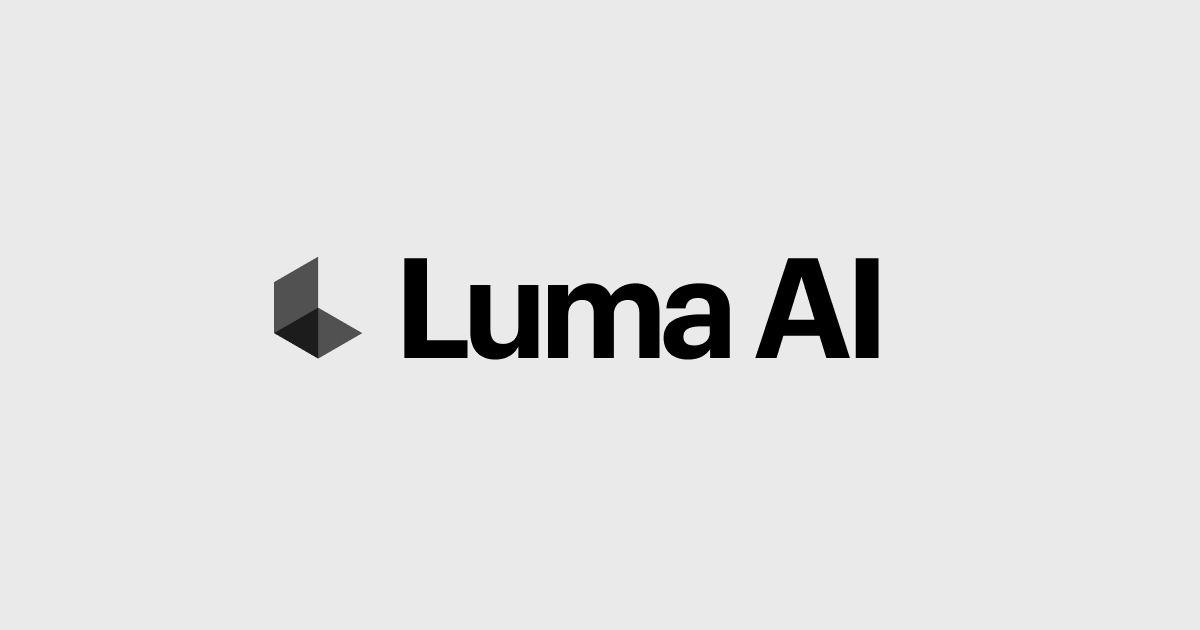Key Takeaways
What is Luma AI? Luma AI is an advanced multimedia generation platform that enables creators to produce high-quality videos, images, and 3D content through AI models, transforming text descriptions and image inputs into dynamic visual content with realistic motion and physics.
- 🚀 Dream Machine (video generation) and Ray2 (large-scale video model) create realistic visuals with coherent motion and convincing physics
- ⏱️ Standard output is 5-second clips with tools for extending, looping, and controlling with keyframes
- 💡 Excels at natural movement physics compared to competitors like Runway, Kling, and Pika
- 🔄 Ray2 Flash provides 3x faster generation at one-third cost for efficient workflows
- ⚙️ Detailed prompts specifying camera movements, lighting and scene elements yield best results
- ⚠️ Professional workflows require generating hundreds of variations (approximately 500 clips for 1 minute of final video)
This review covers: features, integrations, customization, hosting, pricing, pros and cons, and real-world use cases.
What is Luma AI?
Luma AI is a multimodal artificial intelligence platform that specializes in generating high-quality videos and images from text prompts or existing images. The company describes its mission as building “multimodal general intelligence that can generate, understand, and operate in the physical world.”
Use Cases
Content Creation and Marketing:
- 🎥 Generating product demonstration videos without expensive production
- 📱 Creating promotional content and social media assets quickly
- 🖼️ Visualizing marketing concepts before committing to full production
- 📢 Producing dynamic advertisements from static product images
Media and Entertainment:
- 🎬 Previsualization for films, animations, and other visual media
- 💭 Creating concept videos for pitching ideas to stakeholders
- 🌆 Generating background footage and atmospheric scenes
- 🧪 Exploring creative concepts without full production costs
Product Design and Visualization:
- 📦 Converting product images into dynamic showcases
- 🏙️ Demonstrating products in various environments and contexts
- 🔄 Creating visual variants of products for testing market appeal
- 👤 Generating lifestyle imagery showing products in use
Education and Demonstration:
- 📚 Creating instructional videos with consistent visual quality
- 🧠 Visualizing abstract concepts for educational content
- 👨🏫 Developing training materials with animated demonstrations
- 📊 Illustrating processes and procedures with visual examples
Game Development and Virtual Environments:
- 🎮 Generating concept art and test animations
- 🌳 Creating environmental visuals and atmosphere simulations
- 🏃 Developing character movements and interactions
- 🔍 Testing visual concepts before full implementation
User Interface and Ease of Use
🖥️ Platform Availability Luma AI provides both web and iOS interfaces, centered around prompt-based workflows where users input text descriptions or upload images.
💬 Prompt Enhancement The system automatically enhances user prompts through its own language model to optimize results without requiring extensive technical knowledge.
⏳ Processing Queue The platform uses a queue-based processing approach where generations take approximately two minutes once reaching the front, though wait times can be longer during peak usage.
🔄 User Experience Balance Luma AI offers both simple prompt entry for beginners and detailed specification options for professionals, with the prompt-enhancement feature bridging the gap between basic ideas and detailed specifications.
Input Methods and Compatibility
📝 Text-to-Video Generation Accepts both simple and complex prompts, with better results typically coming from detailed descriptions that specify scene elements, camera movements, and visual styles.
🖼️ Image-to-Video Animation Users can upload existing images which Luma AI animates according to provided directions, maintaining visual consistency better than text-only prompts.
📱 Device Compatibility Accessible through modern web browsers on desktop computers and through a dedicated iOS application, with some features available for Android users but full functionality more developed for iOS.
💡 Example: A product photographer can upload a static image of a new consumer device, and with a detailed prompt about desired camera movements, have Luma AI generate a professional-looking 360° product showcase in minutes instead of setting up complex photo rigs.
Supported Features and Editing Tools
🛠️ Core Technologies Dream Machine serves as the primary video generation tool, while Ray2 represents its advanced, large-scale video model capable of producing realistic visuals with natural motion.
⚡ Processing Options Ray2 Flash offers a more accessible version that generates results three times faster at one-third the cost, making it suitable for quick iterations.
🎥 Specialized Creative Tools:
- Camera Motion Concepts: Controls camera movements within generated videos
- Keyframe Controls: Enables precise direction of scene transitions and movements
- Extension and Looping: Allows users to create longer sequences
- Frame Control: Users can specify starting and ending frames
⏱️ Length Limitations Standard generations produce 5-second clips, but users can create longer content by using the last frame of one generation as input for another.
📤 Export Capabilities The platform focuses primarily on generation rather than extensive post-production, requiring external video editing software for complex editing.
Rendering Quality and Output Versatility
🏆 Motion Realism Luma AI’s rendering quality distinguishes itself through realistic motion and physics simulation, particularly with human and object movements including complex actions.
🎦 Video Resolution Videos are generated at 1280×720 resolution, providing reasonably detailed output suitable for most digital applications.
📋 Prompt Interpretation The system successfully renders specific camera techniques like tracking shots with proper perspective and motion blur based on prompt descriptions.
⚠️ Quality Challenges Occasional issues include visual coherence at frame edges, with some warping or blending artifacts in complex scenes, and inconsistencies in facial details across frames.
🎞️ Output Format Luma AI generates mp4 files compatible with major video editing software, typically producing 5-second clips that can be concatenated for longer sequences.
📐 Aspect Ratio Limitations The system currently focuses on standard widescreen format rather than offering specialized format options for different platforms or aspect ratios.
Performance and Speed
⏱️ Processing Times Standard Dream Machine processing takes approximately two minutes once a prompt reaches the front of the queue, with potential wait times during high demand.
🚀 Faster Options Ray2 Flash addresses speed concerns by offering generations at three times the speed of standard processing for time-sensitive projects.
🔄 Performance Factors Processing times vary based on prompt complexity, number of characters, motion complexity, and specific visual effects requested.
📊 Workflow Efficiency Professional users report needing to generate approximately 500 clips to obtain one minute of usable footage, making processing speed and queue management critical factors.
⚠️ Workflow Consideration: Creative professionals should plan for significant iteration time, as the 98% rejection rate (generating 500 clips for 1 minute of final footage) means queue management becomes a critical production bottleneck during deadlines.
Collaboration and Sharing Options
📤 Basic Sharing The platform provides direct download options and community spaces where users can showcase creations and learn from others.
👥 Team Features Collaboration features appear relatively basic, without prominent real-time collaboration tools or sophisticated project management features.
🗣️ Community Resources Luma maintains an active Discord server where users can connect, share tips, and get assistance, serving as a valuable resource for learning advanced techniques.
🔗 Integration Limitations The sharing capabilities focus primarily on output rather than collaborative creation, suggesting teams would need additional project management tools for complex productions.
Pricing and Licensing
💰 Tiered Structure Luma AI offers options ranging from free to premium subscriptions, each providing a specific number of generations per month:
- Free Tier: 30 generations/month with basic editing features, no commercial usage rights
- Lite Plan ($7.99/month): 70 generations/month with higher support priority
- Standard Plan ($29.99/month): 150 generations/month with commercial rights and watermark removal
- Plus Plan ($51.99/month): 310 generations/month with higher support priority
- Pro Plan ($99.99/month): 480 generations/month for small businesses and production teams
- Premier Plan ($499.99/month): 2,430 generations/month for medium businesses or production studios
📋 Usage Rights All paid plans include downloading capabilities, with commercial usage rights beginning at the Standard tier.
🧮 Generation Economics Each “generation” typically produces a single 5-second video clip, making required generation volume an important consideration for professional projects.
Customer Support and Learning Resources
🆘 Support Channels Multiple support options are available with varying priority levels based on subscription tier.
📚 Learning Resources A Learning Hub contains tutorials, best practices, and community examples to help users understand prompt techniques and workflows.
👥 Community Support The Discord server lets users connect with each other for community-based support and knowledge sharing.
📢 Official Updates Luma maintains a blog and social media presence where new features and capabilities are announced.
📖 Documentation Scope The platform’s documentation covers basic operations but may not be as extensive as more mature software products.
Privacy and Data Security
🔒 Content Privacy All scenes and videos created on the platform remain private by default unless explicitly shared by the user.
📝 Usage Rights Commercial usage rights are available on paid plans, allowing professional application of generated content.
⚠️ Security Considerations Professional users should review the platform’s full privacy documentation before using it for sensitive or high-value projects.
Summary
- 🎥 Luma AI excels at generating short video clips with remarkably realistic physics and motion compared to competitors
- 🔄 The platform offers both text-to-video and image-to-video generation with strong comprehension of motion-based prompts
- ⏱️ Standard output is limited to 5-second clips, though extensions and sequencing are possible
- 💰 Tiered pricing from free (30 generations) to $499.99/month (2,430 generations) accommodates various user needs
- ⚠️ Production workflows require significant iteration, with professionals typically discarding 98% of generated clips
- ✅ Produces videos with remarkably realistic motion and physics simulation
- ✅ Offers both text-to-video and image-to-video generation options
- ✅ Provides specialized tools like Camera Motion Concepts for creative control
- ✅ Includes a free tier for experimentation before committing
- ✅ Ray2 Flash delivers faster generation at lower cost
- ✅ Supports extension and looping for creating longer sequences
- ✅ Active community resources for learning and sharing techniques
- ❌ Standard clips limited to approximately 5 seconds each
- ❌ Requires multiple generations to achieve perfect results (98% rejection rate)
- ❌ Queue system can lead to long wait times during peak demand
- ❌ Occasional artifacts like warping and blurring at frame edges
- ❌ Limited collaborative features for team-based workflows
- ❌ Commercial usage requires higher subscription tiers
- ❌ Complex generations demand detailed prompt engineering skill
Frequently Asked Questions
What devices can I use with Luma AI?
Luma AI is accessible through modern web browsers on desktop computers and through a dedicated iOS application for iPhone users. The iOS app requires iPhone 11 or newer models. Android compatibility is reportedly in development but not yet available. For optimal performance, a stable internet connection is essential as the AI processing occurs on Luma’s servers rather than on your local device.
How long does it take to generate a video with Luma AI?
The actual processing time for a standard video generation is approximately two minutes once your prompt reaches the front of the queue. However, during periods of high demand, your request may be placed in a queue, potentially resulting in longer wait times ranging from several minutes to several hours. Ray2 Flash offers faster generation at approximately three times the speed of standard processing.
What types of content can I create with Luma AI?
Luma AI excels at creating short video clips from text descriptions or existing images. The platform can generate a wide range of content including people in motion, environments, objects with physics interactions, and stylized scenes. It performs particularly well with movement-based prompts like walking, running, or dancing sequences. The system can handle both realistic and more stylized or artistic visual approaches.
Do I own the content I create with Luma AI?
Users have rights to the content they generate according to their subscription level. Free and Lite tier users have personal usage rights, while Standard tier and above include commercial usage rights. All generated scenes remain private by default unless you choose to share them. For specific licensing details, it’s advisable to review Luma AI’s terms of service regarding content ownership and usage rights.
How does Luma AI compare to other AI video generators like Runway or Sora?
Luma AI is frequently compared to other AI video generators like Runway, Kling, Pika, and OpenAI’s Sora. Luma’s key strength is in motion rendering and physics, often producing more natural movement than some competitors. Runway Gen-3 is noted for higher aesthetic quality but shorter clips, while Kling offers comparable quality with different strengths. OpenAI’s Sora reportedly produces higher quality but is not yet publicly available. Each platform has different pricing, availability, and specialized capabilities that may make them more suitable for specific use cases.
Can I create longer videos with Luma AI?
While standard generations produce clips of approximately 5 seconds, Luma AI offers methods to create longer content. Users can employ the extension and looping features or use the last frame of one generation as the starting point for another. Creating longer coherent videos typically requires generating multiple clips and potentially editing them together. Professional users report needing to generate hundreds of clips to produce one minute of polished content, discarding unusable generations in the process.
What kind of support does Luma AI offer if I encounter problems?
Luma AI provides tiered support with priority levels based on your subscription. All users can access basic support, while paid subscribers receive higher priority assistance. The platform maintains a Discord community where users can get help from both staff and other users. Luma also offers a Learning Hub with tutorials and resources to help users understand the platform’s capabilities and techniques for optimal results.
Ready to try Luma AI? Visit the official site



